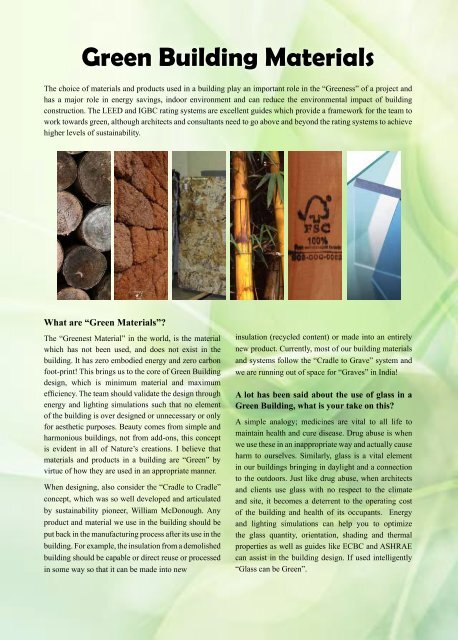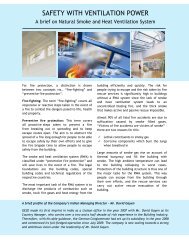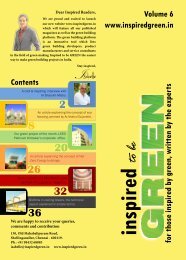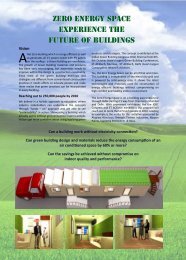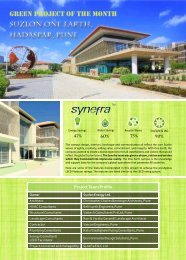Dear Inspired Readers - Inspired to be Green
Dear Inspired Readers - Inspired to be Green
Dear Inspired Readers - Inspired to be Green
Create successful ePaper yourself
Turn your PDF publications into a flip-book with our unique Google optimized e-Paper software.
<strong>Green</strong> Building MaterialsThe choice of materials and products used in a building play an important role in the “<strong>Green</strong>ess” of a project andhas a major role in energy savings, indoor environment and can reduce the environmental impact of buildingconstruction. The LEED and IGBC rating systems are excellent guides which provide a framework for the team <strong>to</strong>work <strong>to</strong>wards green, although architects and consultants need <strong>to</strong> go above and <strong>be</strong>yond the rating systems <strong>to</strong> achievehigher levels of sustainability.What are “<strong>Green</strong> Materials”?The “<strong>Green</strong>est Material” in the world, is the materialwhich has not <strong>be</strong>en used, and does not exist in thebuilding. It has zero embodied energy and zero carbonfoot-print! This brings us <strong>to</strong> the core of <strong>Green</strong> Buildingdesign, which is minimum material and maximumefficiency. The team should validate the design throughenergy and lighting simulations such that no elemen<strong>to</strong>f the building is over designed or unnecessary or onlyfor aesthetic purposes. Beauty comes from simple andharmonious buildings, not from add-ons, this conceptis evident in all of Nature’s creations. I <strong>be</strong>lieve thatmaterials and products in a building are “<strong>Green</strong>” byvirtue of how they are used in an appropriate manner.When designing, also consider the “Cradle <strong>to</strong> Cradle”concept, which was so well developed and articulatedby sustainability pioneer, William McDonough. Anyproduct and material we use in the building should <strong>be</strong>put back in the manufacturing process after its use in thebuilding. For example, the insulation from a demolishedbuilding should <strong>be</strong> capable or direct reuse or processedin some way so that it can <strong>be</strong> made in<strong>to</strong> newinsulation (recycled content) or made in<strong>to</strong> an entirelynew product. Currently, most of our building materialsand systems follow the “Cradle <strong>to</strong> Grave” system andwe are running out of space for “Graves” in India!A lot has <strong>be</strong>en said about the use of glass in a<strong>Green</strong> Building, what is your take on this?A simple analogy; medicines are vital <strong>to</strong> all life <strong>to</strong>maintain health and cure disease. Drug abuse is whenwe use these in an inappropriate way and actually causeharm <strong>to</strong> ourselves. Similarly, glass is a vital elementin our buildings bringing in daylight and a connection<strong>to</strong> the outdoors. Just like drug abuse, when architectsand clients use glass with no respect <strong>to</strong> the climateand site, it <strong>be</strong>comes a deterrent <strong>to</strong> the operating cos<strong>to</strong>f the building and health of its occupants. Energyand lighting simulations can help you <strong>to</strong> optimizethe glass quantity, orientation, shading and thermalproperties as well as guides like ECBC and ASHRAEcan assist in the building design. If used intelligently“Glass can <strong>be</strong> <strong>Green</strong>”.


